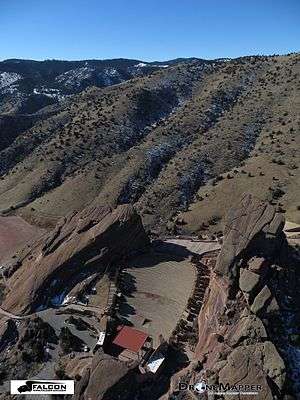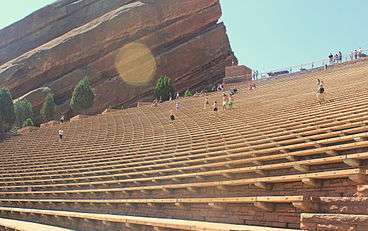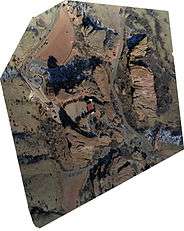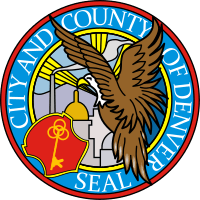Red Rocks Amphitheatre
 | |
 | |
| Location | 17598 W Alameda Pkwy, Morrison, CO 80465 |
|---|---|
| Owner | City and County of Denver |
| Operator | City and County of Denver |
| Capacity | 9,525 |
| Opened | 1906 |
| Website | |
|
redrocksonline | |
Red Rocks Amphitheatre is a rock structure near Morrison, Colorado, 10 miles west of Denver, where concerts are given in the open-air amphitheatre. Red Rocks Amphitheater is a naturally formed, world famous outdoor venue just fifteen miles west of Denver.[1] There is a large, tilted, disc-shaped rock behind the stage, a huge vertical rock angled outwards from stage right, several large outcrops angled outwards from stage left and a seating area for up to 9,525 people[2] in between. The amphitheater is owned and operated by the City and County of Denver, Colorado and is located in Red Rocks Park, part of the Denver Mountain Parks system.
History
In the first decade of the twentieth century, John Brisben Walker had a vision of artists performing on a stage nestled in the perfect acoustic surroundings of Red Rocks, which likely were used by the Ute tribe in earlier times. Walker produced a number of concerts between 1906 and 1910 on a temporary platform; and from his dream, the history of Red Rocks as an entertainment venue began.[3] In addition to the platform, Walker also built the Mount Morrison Cable Incline funicular railway which carried tourists from a base at what is today the parking lot of the amphitheatre up to enjoy the view from the top of Mount Morrison; the incline operated for about five years beginning in 1909.[4]
Geologically, the rocks surrounding the amphitheater are representative of the Fountain Formation. Originally the place was known as the "Garden of the Angels" (1870s-1906), and then as "Garden of the Titans" during the Walker years (1906–1928). The park, however, had always been known by the folk name of "Red Rocks", which became its formal name when Denver acquired it in 1928. The amphitheater's rocks are named "Creation Rock" on the north, "Ship Rock" on the south, and "Stage Rock" to the east. Red Rocks Amphitheatre was designed by Denver architect Burnham Hoyt.
In 1927, George Cranmer, Manager of Denver Parks, convinced the City of Denver to purchase the area of Red Rocks from Walker for the price of $54,133 ($737,382 in 2015 dollars[5]). Cranmer convinced Benjamin Franklin Stapleton, the Mayor of Denver, Colorado, to build on the foundation laid by Walker. By enlisting the help of the Civilian Conservation Corps (CCC), and Works Progress Administration (WPA), labor and materials were provided for the venture. Construction of the amphitheatre began in 1936 and was completed in 1941.[6]
Performances
Public, organizational and private performances have been held at Red Rocks for more than 100 years. The earliest documented performance at the amphitheater was the Grand Opening of the Garden of the Titans, put on by famed editor John Brisben Walker on May 31, 1906. Featuring Pietro Satriano and his 25-piece brass band, it was the formal opening of the natural amphitheater for use by the general public after Walker purchased it with the proceeds of his sale of Cosmopolitan Magazine.
The amphitheater's largest-scale performance to date was the Feast of Lanterns on September 5, 1908. Commemorating the opening of the scenic road up nearby Mt. Falcon, it was patterned after the festival of Nagasaki, Japan, and featured four military bands and fireworks off Mt. Falcon, Mt. Morrison and two intermediate hills.
Renowned opera singer Mary Garden put Red Rocks on the world musical map with her performance on May 10, 1911. Having performed at many opera halls around the world, she pronounced Red Rocks the finest venue at which she had ever performed. In 1987 Stevie Nicks played at Red Rocks to a rapturous audience.
Upon the full construction of the amphitheatre to its present form by the Civilian Conservation Corps, the venue was formally dedicated on June 15, 1941. It has held regular concert seasons every year since 1947.
The first performance of each season is the Easter Sunrise Service, a non-denominational service on Easter Sunday of each year.
The earliest notable rock-and-roll performance at Red Rocks was by The Beatles on August 26, 1964, the only concert not sold out during their US-tour. When Ringo Starr returned to Red Rocks with his All-Starr Band on June 28, 2000, he asked if anyone in the crowd had been at the Beatles concert thirty-six years earlier. On August 26, 2004, the East-Coast-based Beatles-tribute band, "1964" was flown to Denver to re-enact the Beatles concert held at the site exactly forty-years earlier to the date. The beautiful and unique setting has led to the venue becoming a favorite for many performers. Jimi Hendrix played at Red Rocks on September 1, 1968, along with Vanilla Fudge and Soft Machine.
An incident during a performance by Jethro Tull on June 10, 1971, led to a five-year ban of rock concerts at Red Rocks.[7][8] Approximately 1,000 people without tickets arrived at the sold-out show. Denver police directed the overflow, non-paying crowd to an area behind the theater, where they could hear the music but not see the band. The situation seemed satisfactory until some of the people without tickets attempted to enter the amphitheatre by charging at, and breaking through, the police line. Some of those without tickets began lobbing rocks at the police, and the police responded by discharging tear gas at the gate-crashers. The wind carried the tear gas over the hill, into the paying crowd and onto the stage. Following the "Riot at Red Rocks," Denver Mayor William H. McNichols, Jr. banned rock concerts from the amphitheatre. For the next five years, shows at Red Rocks were limited to softer acts, such as John Denver, Sonny & Cher, The Carpenters, Pat Boone, Seals & Crofts, and Carole King. The ban on rock and roll was finally lifted through legal action taken by Denver concert promoter Barry Fey, who tried to book the band America at the venue in 1975. After being denied a permit by the city, Fey took the city to court, and the court ruled that the city had acted "arbitrarily and capricious" in banning rock concerts at Red Rocks. Starting in the summer of 1976, the rock bands were once again welcomed at the venue. Jethro Tull played Red Rocks again on August 12, 2008 and on June 8, 2011.
U2 performed at the amphitheatre on June 5, 1983 during their War Tour, in front of a crowd of 9,000 people. The show was filmed for the group's concert film U2 Live at Red Rocks: Under a Blood Red Sky. The show was recorded and part of it was used for the group's live album Under a Blood Red Sky.
Depeche Mode performed at the amphitheatre four times: the first time was July 1, 1986. The second and third were on July 11 and 12, 1990 during their World Violation Tour. The fourth was on August 27, 2009 during their Tour of the Universe, in front of a crowd of 8,679 people. The show was recorded for the group's live albums project Recording the Universe.
Red Rocks was one of the favored venues for The Grateful Dead and the venue has become a traditional stop for many subsequent jam bands. Widespread Panic holds the record for the most sold out performances at Red Rocks Amphitheatre (51 shows).[9] Blues Traveler has played the venue every Fourth of July since 1993, except 1999 when lead singer and harmonica player John Popper was unable to play due to heart surgery.[10]
Geddy Lee of the rock band Rush said, "It's an amazing location. One of the most beautiful concert venues in America...or anywhere. I would hazard a guess that it's one of the most beautiful anywhere."[11] Rush played Red Rocks on their R30 30th Anniversary, Snakes and Arrows, and Time Machine tours.
Notable recordings
Red Rocks has been a popular venue for live recordings, particularly videos due to the visual uniqueness of the setting. During the 1970s and 1980s, local folk-rocker John Denver recorded several world-televised concerts at Red Rocks. U2's 1983 concert video, Live at Red Rocks: Under a Blood Red Sky, became a best-selling long-form concert video and the performance of "Sunday Bloody Sunday" was played frequently on MTV. Fleetwood Mac singer Stevie Nicks released a 60-minute-long DVD of her 1986 concert at the amphitheatre, towards the end of her Rock a Little tour. In 1992 The Moody Blues performed live for the first time with a symphony orchestra for a PBS special "A Night at Red Rocks with the Colorado Symphony Orchestra". The concert also was released on CD and DVD along with a companion DVD "The Other Side of Red Rocks" which documented the rehearsals and preparation for the concert and excerpts from the concert.

Other Red Rocks material on CD and DVD includes Dave Matthews Band's albums Live at Red Rocks 8.15.95 and the CD/DVD Weekend on the Rocks, which is a compilation of the band's four night run in 2005 Also recorded are The Samples live album, Live in Colorado, John Tesh's Live at Red Rocks and Worship at Red Rocks, the Incubus DVD Alive at Red Rocks, Blues Traveler's Live on the Rocks album, Steve Martin's comedy album A Wild and Crazy Guy, The Moody Blues's A Night at Red Rocks with the Colorado Symphony Orchestra, and Boukman Eksperyans' album "Live At Red Rocks". Widespread Panic's DVD "The Earth Will Swallow You" features a 15 min segment on Red Rocks.
The live Neil Young album, Road Rock Vol. 1, and its accompanying DVD Red Rocks Live were filmed and recorded at Red Rocks in 2000 during the "Silver and Gold" tour. Local Colorado band Big Head Todd and the Monsters released a DVD and live album of a notable 1995 performance in 2003, capturing what has become a local annual early season tradition. In 2009, they followed the original recording up with a 2-CD/1DVD set from their June 2008 performance.
A two-volume 2003 album, Carved in Stone, features live performances by various artists at Red Rocks, including R.E.M., Ben Harper, Coldplay, The Allman Brothers Band, and Phish, with proceeds going towards a fund for preservation of the park and amphitheatre.
Phish frontman, Trey Anastasio included excerpts from his 2005 performance at Red Rocks on the DVD that accompanied his album "Shine." Country music superstar Gary Allan filmed the music video for his song "Watching Airplanes" during a live sell-out concert at Red Rocks in August 2007. A portion of British rock band Oasis's rockumentary film "Lord Don't Slow Me Down" was filmed at Red Rocks. A Perfect Circle also included one live video recording on the CD/DVD AMotion. Insane Clown Posse played with Twiztid, Blaze Ya Dead Homie, Boondox, the Axe Murder Boyz, Grave Plott, The ROC, and Motown Rage in May 2008 at Red Rocks at perform the 'first annual' Hatchet Attacks Super Show, for which they released a video later that year.
Depeche Mode recorded their show at the amphitheatre on August 29, 2009, for their live albums project Recording the Universe.
Country superstar Kenny Chesney included a live version of You and Tequila, a duet with Grace Potter, on his latest album Welcome to the Fishbowl. The recording has a segment with audience participation singing the chorus "You and Tequila make me crazy, run like poison in my blood, one more night could kill me baby, one is one too many, one more is never enough".
A Perfect Circle recorded the DVD portion of their A Perfect Circle Live: Featuring Stone and Echo box set on August 2, 2011. Also included in the box set is a CD of the audio from the show.
On August 29, 2012 Mumford & Sons recorded their live performance of their first single "I Will Wait" from their new CD Babel at the Red Rocks Amphitheatre. The performance was released on September 9, 2012 as the band's official video for the song.[12] The band released a full-length DVD of their show at Red Rocks, recorded on 28 and 29 August 2012, entitled The Road To Red Rocks.
On August 31, 2014 Joe Bonamassa performed a special concert at Red Rocks featuring the music of blues legends Muddy Waters and Howlin’ Wolf which was recorded for PBS and Palladia.
On June 10, 2015 Barenaked Ladies performed at Red Rocks on their Last Summer on Earth 2015 tour. The performance was aired on AXS TV, then later released on May 20, 2016 as a live album titled BNL Rocks Red Rocks.[13]
In film and television
A portion of a filmed concert at Red Rocks of country artist Waylon Jennings, was included in His 1980 ABC TV special entitled Waylon.
Part of the film The Adventures of Ford Fairlane was filmed at Red Rocks. Opening sequences feature the fictional rock band "Black Plague" playing at Red Rocks Amphitheatre where lead singer Bobby Black (played by Vince Neil) makes a grand entrance hanging from the rock face of the landmark red rocks above the crowd swooping on stage via zipline.[14]
The amphitheatre was the start and finish line of the reality show The Amazing Race 9.
The Red Rocks Amphitheatre was featured in an episode of South Park, as the location of a Jonas Brothers concert.
The Red Rocks formations were featured in an episode of Dr. Quinn, Medicine Woman entitled, "Last Dance", where the character of Sully, in 1871, determined to work toward convincing the government to designate the entire area as a protected national park.
Rapper B.o.B. filmed his music video "Don't Let Me Fall" at Red Rocks. The music video was released on YouTube on November 17, 2010.
Zac Brown Band filmed their song "Keep Me In Mind" on Red Rocks.
The group Train with singer Ashley Monroe filmed the music video "Bruises" at Red Rocks in late summer of 2012. The video was officially released on Train's official Vevo account on November 12, 2012.
The American band OneRepublic partially filmed the music video for their single "I Lived" at Red Rocks in the summer of 2014.
On October 28, 2016 reggae rock band Rebelution released their live filmed concert DVD "Live At Red Rocks"[15]
Colorado Music Hall of Fame
In June 2015, the Colorado Music Hall of Fame opened its doors in the Trading Post at Red Rocks.[16]
Honors
- After Pollstar magazine awarded Red Rocks the honor of best small outdoor venue for the 11th time, the leading concert industry magazine decided to name the nationally coveted honor the Red Rocks Award—and remove Red Rocks from the running. It is voted on annually by the magazine's membership.
- The American Institute of Architects selected Red Rocks to be Colorado's entry at the National Gallery of Art for the AIA's Centennial Exhibition in 1957.
Gallery
 Red Rocks Amphitheatre Seating
Red Rocks Amphitheatre Seating Red Rocks Amphitheatre
Red Rocks Amphitheatre Scale model at Visitor's Center
Scale model at Visitor's Center Red Rocks Aerial Photogrammetry Mission
Red Rocks Aerial Photogrammetry Mission Downtown Denver view from Red Rocks Amphitheatre
Downtown Denver view from Red Rocks Amphitheatre
See also
| Wikimedia Commons has media related to Red Rocks Amphitheatre. |
- List of contemporary amphitheatres
- Red Rocks Park
- Live at Red Rocks: Under a Blood Red Sky (1983) – a live video by U2
- Live at Red Rocks 8.15.95 (1997) – a live album by Dave Matthews Band
- Weekend on the Rocks (2005) – a live album/DVD by Dave Matthews Band
- Night Visions Live (2014) – a live album/video by Imagine Dragons
References
- ↑ "Back Matter". The American Biology Teacher. 70 (9). 1 January 2008. doi:10.2307/27669350. JSTOR 27669350.
- ↑ "Red Rocks Entertainment Concerts | Visitor Info | Visitor Faq". redrocksonline.com. Retrieved 2016-01-27.
- ↑ "Red Rocks Entertainment Concerts – About – History Geology".
- ↑ "Trail's End – Inclines and Funicular Railways in Colorado – Colorado Gambler". 2014-09-03. Retrieved 2016-06-28.
- ↑ "Inflation Calculator: Bureau of Labor Statistics".
- ↑ Red Rocks Park Timeline of the 1930s and 1940s, from Denvergov.org
- ↑ Thomas J. Noel, Sacred Stones: Colorado's Red Rocks Park & Amphitheatre, pages 74–75. ISBN 978-0-9729530-0-9
- ↑ "Jethro Tull Press: Los Angeles Free Press, 18 June 1971". Tullpress.com. June 18, 1971. Retrieved October 24, 2012.
- ↑ "Widespread Panic Closes in on 50 Consecutive Sold Out Red Rocks Shows – Marquee Magazine".
- ↑ "Blues Traveler for the Fourth: A Red Rocks tradition for more than 20 years – The Denver Post". Retrieved 2016-06-04.
- ↑ Rush Interview
- ↑ "Mumford & Sons Match Grandeur of Red Rocks on 'I Will Wait'. Rolling Stone. Retrieved September 24, 2012
- ↑ Linkfire.com. "BNL Rocks Red Rocks (Live) by Barenaked Ladies".
- ↑ "Vince Neil".
- ↑ http://rebelution.shop.musictoday.com/store/. Missing or empty
|title=(help) - ↑ Schiff, Mark (June 12, 2015). "Colorado Music Hall of Fame moves into its new home at Red Rocks". AXS. Retrieved 15 June 2015.
External links
Coordinates: 39°39′55″N 105°12′21″W / 39.66528°N 105.20583°W

